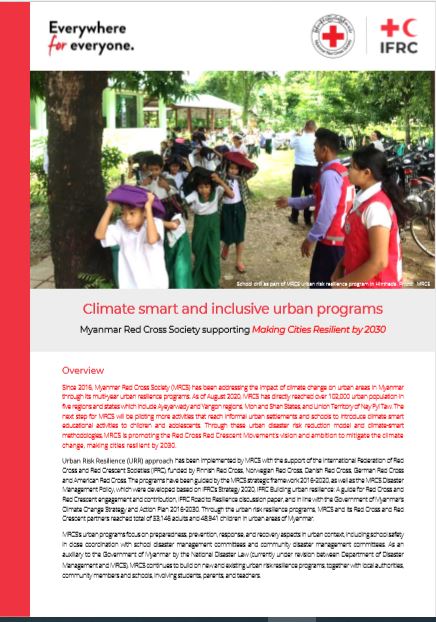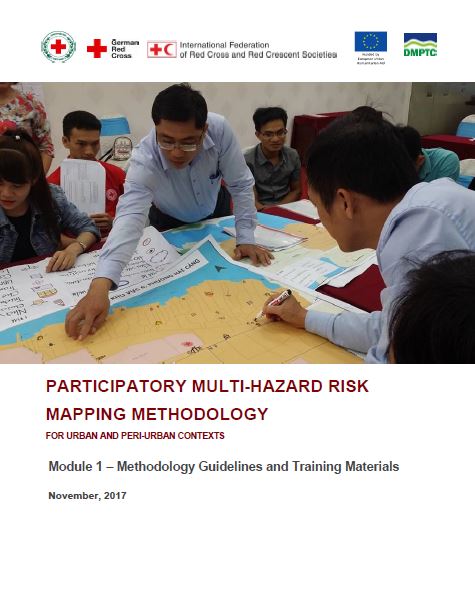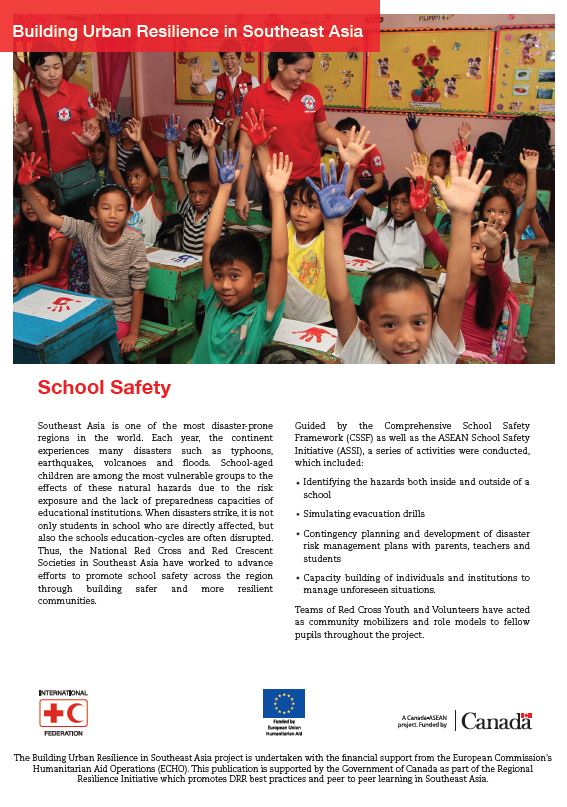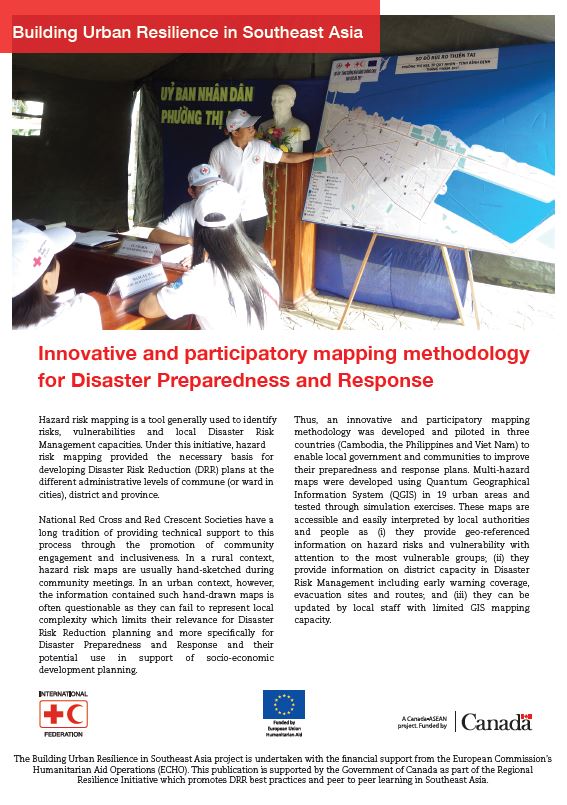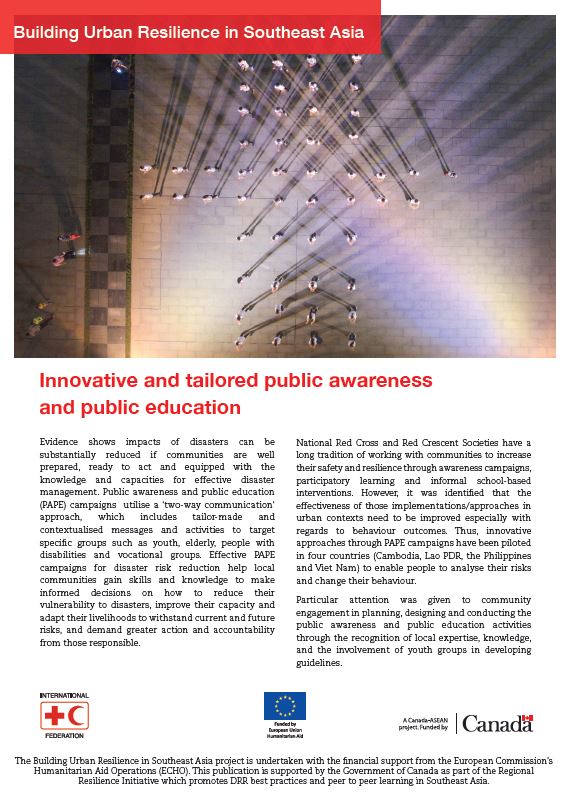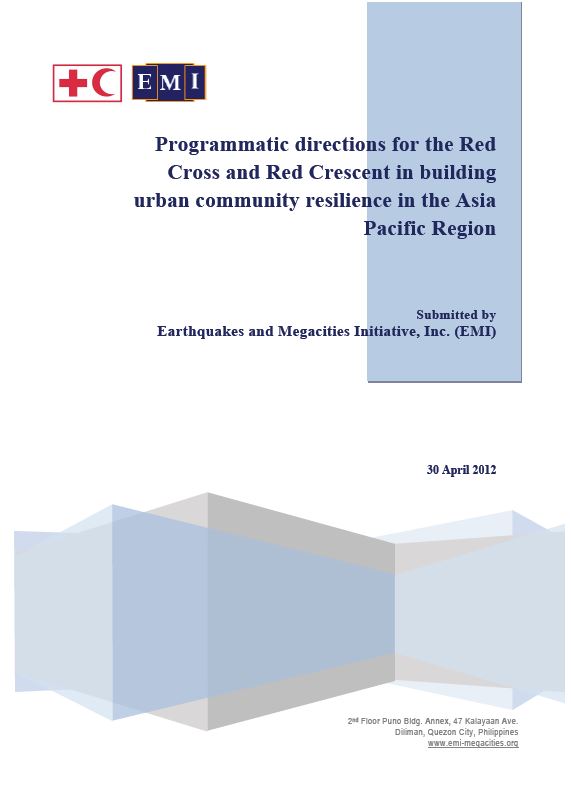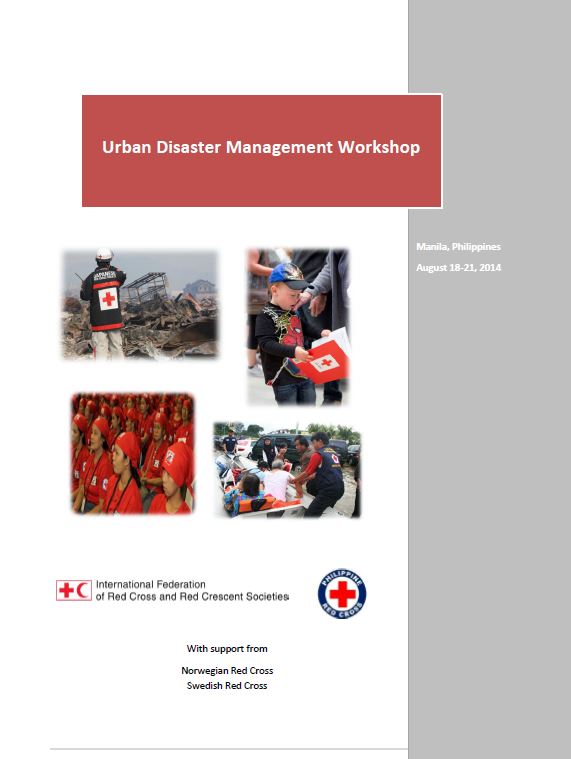Participatory multi-hazard risk mapping methodology for urban and peri-urban contexts
As part of the project “Building urban resilience in South East Asia”, funded by European Union humanitarian aid and coordinated by the International Federation of Red Cross and Red Crescent Societies (IFRC), the German Red Cross (GRC) and the Vietnam Red Cross (VNRC) have taken the lead in the development of this new methodology. Being improved from the participatory risk mapping method developed by GRC2, the new methodology has been then piloted in three countries (Cambodia, Philippines and Viet Nam) by the Red Cross National Societies with the support of their Partner National Societies (Finnish Red Cross, German RedCross, Spanish Red Cross).
With this new methodology using Quantum Geographic Information System, QGIS multi-hazard risks maps have been developed in nineteen urban areas and tested through simulation exercises. Those maps are easy to understand to local authorities and people; they provide geo-referenced information on hazard risks and vulnerability with attention to the most at risk groups; they provide information on ward capacity in DRM including early warning coverage, evacuation sites and routes; and they can be updated by local staff with limited GIS mapping capacity.
The new methodology aims to be used by local government authorities and local Red Cross and is described in two documents, which are logically linked together. The documents provide guidance on the development of multi-hazard risk maps in urban and peri-urban contexts using Quantum Geographical Information System (QGIS). The documents are designed in a way that they can be used as training materials.
Module 1: Methodology Guidelines and Training Materials
The contents of this module will provide DRR practitioners a step-by-step approach for developing, updating and using multi-hazard risk maps for Disaster Risk Reduction in urban context, and basic knowledge in QGIS (concepts, purposes of using QGIS in for developing multi-hazard risk map).
Main parts of Module 1:
o Overview of the methodology
o Phase 1. Develop base maps for multi-hazard risk mapping
o Phase 2. Participatory data collection and consolidation
o Phase 3. Develop and verify the multi-hazard risk map with stakeholder participation
o Phase 4. Share and update maps annually
o Phase 5. Use multi-hazard risk maps for disaster risk reduction
Module 2: Technical Instructions on the use of QGIS for the development and updating of multi-hazard risk maps
The contents of the Module 2 will provide DRR practitioners the detailed instructions for using QGIS for the development and update of multi-hazard risk maps
Main parts of Module 2:
o Part 1: Installation of QGIS software and administrative boundary identification of the mapping areas.
o Part 2: Using of QGIS for the development of multi-hazard risk maps at urban areas.
o Part 3: Updating information and data using the QGIS
o Part 4: Collection of information and data on field with GPS, smartphone and updating the risk map using the QGIS.
To illustrate the different steps for the development and update of multi-hazard risk maps at local level using QGIS, this guideline and training material provide examples in the context of Vietnam. Specifically, cities in this context are divided administratively in two levels: ward and hamlet (at each city there will be wards, under which will be hamlets). Generally in South East Asia, DRR related activities at the lower government level (such as ward and hamlet in Vietnam) are supported by dedicated staff (or group of staff) but with limited capacity. Despite this limitation, through the experience gained during the piloting of this methodology in Vietnam, Philippines and Laos it has been demonstrated that mapping can be done (and have been done) by local government staff if they have been clearly tasked by their leaders for this role. In this guideline, those dedicated local government staff in charge of mapping will be referred as Technical Support Group or TSGs.
See also:
- Case Study: Building Urban Resilience in Southeast Asia – Innovative participatory mapping methodology for disaster preparedness and response
- Module 1: Methodology Guidelines and Training Materials [in VIETNAMESE]
- Module 2: Technical Instructions on the use of QGIS for the development and updating of multi-hazard risk maps in VIETNAMESE
![]()
Case Study: Building Urban Resilience in Southeast Asia – School Safety
The case study highlights Philippine Red Cross and Cambodian Red Cross’ contribution to all three pillars of the Comprehensive School Safety Framework, which include: Building safe learning facilities, establishing school disaster management capacities and promoting risk reduction and resilience education in the participating schools.
Extracted from the Building Urban Resilience in Southeast Asia, an ECHO-funded project, this case study forms a part of the Building Urban Resilience in Southeast Asia series.
![]()
Case Study: Building Urban Resilience in Southeast Asia – Innovative participatory mapping methodology for disaster preparedness and response
Hazard risk mapping is a tool generally used to identify risks, vulnerabilities and local Disaster Risk Management capacities. Under this initiative, hazard risk mapping provided the necessary basis for developing Disaster Risk Reduction (DRR) plans at the different administrative levels of commune (or ward in cities), district and province.
An innovative and participatory mapping methodology was developed and piloted in three countries (Cambodia, the Philippines and Viet Nam) to enable local government and communities to improve their preparedness and response plans. Multi-hazard maps were developed using Quantum Geographical Information System in 19 urban areas and tested through simulation exercises. Read the related methodology in more detailed: Participatory multi-hazard risk mapping methodology for urban and peri-urban contexts
Extracted from the Building Urban Resilience in Southeast Asia, an ECHO-funded project, this case study forms a part of the Building Urban Resilience in Southeast Asia series.
![]()
Case Study: Building Urban Resilience in Southeast Asia – Innovative and tailored public awareness and public education
The case study is extracted from the Building Urban Resilience in Southeast Asia, an ECHO-funded project, which features innovative approaches through public awareness and public education campaigns to enhance community safety and resilience, piloted in Cambodia, Lao PDR, the Philippines and Vietnam.
The case study forms a part of the Building Urban Resilience in Southeast Asia series.
![]()
How To Make Cities More Resilient: A Handbook for Local Government Leaders
Purpose
This Handbook for Local Government Leaders provides mayors, governors, councillors and others with a generic framework for risk reduction and points to good practices and tools that are already being applied in different cities for that purpose. It responds to the following key questions: WHY building disaster resilience is beneficial; WHAT kind of strategies and actions are required; and HOW to go about the task. Because cities, towns and municipalities differ in size, social, economic and cultural profiles and exposure to risk, each one will approach the tasks differently.
The message is: resilience and disaster risk reduction must be part of urban design and strategies to achieve sustainable development. They require strong alliances and broad participation. Applying the guiding principles of the “Making Cities Resilient” Campaign and the information in this Handbook will help cities and local governments to share learning, access information, develop indicators and performance measures and track progress.
Usage: Guideline for implementation
Audience: Local government leaders such as mayors, governors and councillors
![]()
Urban Disaster Management Workshop | 18-21 August 2014 | Manila, Philippines
The Urban Disaster Management workshop organized by Philippine Red Cross and IFRC, with the support of Norwegian Red Cross and Swedish Red Cross on 18-21 August 2014, in Manila, the Philippines, was a direct response to the many voices raised by National Societies to address urban Disaster Management issues with a progressive strategic and operational approach to urban preparedness, response and recovery.
The workshop brought together representatives from 15 National Societies from Asia-Pacific region, in addition to Partner National Societies, IFRC Secretariat, the ICRC, a range of representatives from Government authorities, UN, NGOs, academic and private institutions.
Objectives of the workshop:
- Increase knowledge on emerging urban Disaster Management issues & sharing of National Societies good practice.
- Provide directions for future strategic work – including a framework for the Asia Pacific zone on urban DRR and DM strategy.
- Identify needs and opportunities for innovative approaches to urban Disaster Management.
- Provide inputs to RCRC Asia Pacific statutory conference in Beijing, October 2014.
- Provide inputs to the IFRC Global Approach and Guidelines on Urban DRR/DM.
- Provide informed discussion on operational tools and services within the RCRC.
The various sessions throughout the workshop, including presentations, panels, group discussions and technical breakout sessions, discussed a range of various themes key to the urban environment, including, but not limited to:
- Contingency Planning in Urban contexts
- Urban Volunteer Management
- Cash Transfer Programming
- Urban Risk Assessment
- Disaster Law in urban contexts
- Violence in urban contexts
- Engaging with multiple stakeholders
- Environment and climate change
- Lessons learnt from the Haiyan response
Following the feedback and prioritized discussion topics of the Disaster Management Reference Group, the workshop was structured with the guiding questions, including:
- Where do we come from?
- Where do we want to go?
- How do we do it?
See also: Report of the workshop
![]()
Building Urban Resilience Workshop | 30-31 July 2016 | Bangkok, Thailand
Panel discussion on what is urban resilience and what is happening across the region
The workshop brought together more than 40 participants from eight Red Cross/Red Crescent (RC/RC) National Societies as well as government counterpart agencies and partner organizations to share learning and insights on building disaster preparedness and resilience in urban settings in Asia.
The workshop looked at existing experience within the RC/RC and at where national societies want to be in the future in supporting communities to achieve resilience in urban settings. Many of the points raised in the workshop were in line with recent studies on this topic in Asia and elsewhere by the RC/RC and other organizations.
The workshop built on lessons from a related event held in Arusha, Tanzania in February 2013. will be followed by a third workshop in Latin America in September 2013. The workshop itself was captured live on Storify at https://storify.com/SM4Resilience/building-urban-resilience-july-30th-31st-2013
Conclusions of the workshop include:
- Integrated approaches are needed across sectors to reduce duplication, maximize efficiencies, and benefit from community synergies that strengthen resilience.
- It is too ambitious to assume the RC/RC can or do it alone to support community resilience in isolation from other partners that can help to bring a focus on such areas as economic and investment, infrastructure, and business continuity.
- Effective strategies are needed to ensure that the RC/RC does not spread itself too thin and can focus on its core strengths in community programming. The use of coalitions at local, national, and global levels can help ensure effective partnering for community service delivery, advocacy, and resource mobilization.
See also: Report of the workshop
![]()
Programmatic directions for the Red Cross and Red Crescent in building urban community resilience in the Asia Pacific Region
Purpose:
This report is submitted following the contractual obligations of EMI to the IFRC Asia Pacific Zone for the project titled “Research Study to Identify Red Cross and Red Crescent Niche in Urban Community Resilience Programming in Asia Pacific.”
It presents the results of EMI’s analytical study and provides guidance to IFRC in determining its role in urban disaster risk reduction. It also provides additional information, materials, tools, methodologies and approaches that can be included in the existing Federation DRR and response materials/tools and highlights areas that require amendment to suit the urban context.
Overview:
The study identified four key issues that characterise existing RCRC programmes and activities in urban areas:
- Most of the DRR programmes and approaches have been designed for rural communities or adapted from rural experiences.
- There is limited experience in establishing systematic processes that access, gather and integrate information on city-level hazard, vulnerability and risk into programmes and policy formulation.
- National Societies lack adequate experience in working with local authorities, professional organisations, private sector, academia, and other local urban actors. They are also not integrated and active in global urban DRR/CCA initiatives.
- IFRC guidelines, training materials and manuals have been mostly designed for rural communities and National Societies face difficulties in adapting them to their national/local contexts.
Below is the proposition made by the study on several strategies to addres the gaps identified and build on RCRC strength and capabilities (for more information, see Executive Summary of the report, p. vi).
Usage: Policy reference
Audience: National Society leaders and managers
See also: The inception report of this research study [pdf, 0.83 MB]
![]()
Urban Disaster Management Workshop Report 2014
Purpose:
The report summarizes the workshop result of the Urban Disaster Management, by highlighting the workshop key messages.
Overview of the workshop:
The Urban Disaster Management workshop organized by Philippine Red Cross and IFRC, with the support of Norwegian Red Cross and Swedish Red Cross on 18-21 August 2014, in Manila, the Philippines, was a direct response to the many voices raised by National Societies to address urban Disaster Management issues with a progressive strategic and operational approach to urban preparedness, response and recovery.
The workshop brought together representatives from 15 National Societies from Asia-Pacific region, in addition to Partner National Societies, IFRC Secretariat, the ICRC, a range of representatives from Government authorities, UN, NGOs, academic and private institutions.
Objectives of the workshop:
- Increase knowledge on emerging urban Disaster Management issues & sharing of National Societies good practice.
- Provide directions for future strategic work – including a framework for the Asia Pacific zone on urban DRR and DM strategy.
- Identify needs and opportunities for innovative approaches to urban Disaster Management.
- Provide inputs to RCRC Asia Pacific statutory conference in Beijing, October 2014.
- Provide inputs to the IFRC Global Approach and Guidelines on Urban DRR/DM.
- Provide informed discussion on operational tools and services within the RCRC.
The various sessions throughout the workshop, including presentations, panels, group discussions and technical breakout sessions, discussed a range of various themes key to the urban environment, including, but not limited to:
- Contingency Planning in Urban contexts
- Urban Volunteer Management
- Cash Transfer Programming
- Urban Risk Assessment
- Disaster Law in urban contexts
- Violence in urban contexts
- Engaging with multiple stakeholders
- Environment and climate change
- Lessons learnt from the Haiyan response
Following the feedback and prioritized discussion topics of the Disaster Management Reference Group, the workshop was structured with the guiding questions, including:
- Where do we come from?
- Where do we want to go?
- How do we do it?
Usage: Learning from experience and initiatives
Audience: National Society managers and staff
![]()


